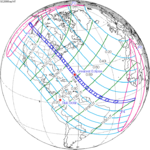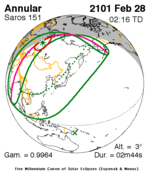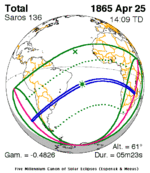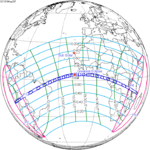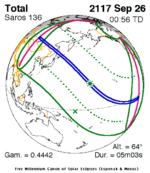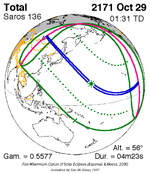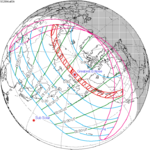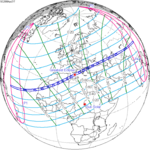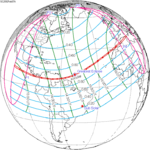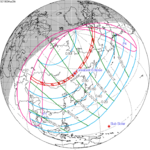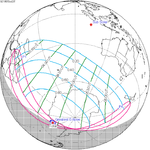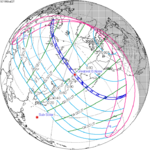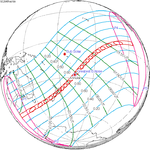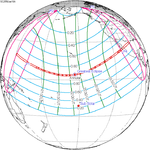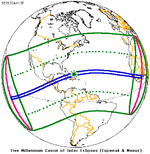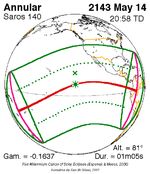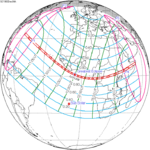|
Solar eclipse of September 14, 2099
A total solar eclipse will occur at the Moon's descending node of orbit on Monday, September 14, 2099,[1] with a magnitude of 1.0684. A solar eclipse occurs when the Moon passes between Earth and the Sun, thereby totally or partly obscuring the image of the Sun for a viewer on Earth. A total solar eclipse occurs when the Moon's apparent diameter is larger than the Sun's, blocking all direct sunlight, turning day into darkness. Totality occurs in a narrow path across Earth's surface, with the partial solar eclipse visible over a surrounding region thousands of kilometres wide. Occurring about 5 hours before perigee (on September 15, 2099, at 12:20 UTC), the Moon's apparent diameter will be larger.[2] Locations experiencing totalityThe eclipse will begin at sunrise off the western coast of Canada, and move eastern across Canada (British Columbia, Alberta, and Saskatchewan) and the northern states of the United States (Montana, North Dakota, South Dakota, Minnesota, Wisconsin, Illinois, Indiana, Michigan, Ohio, Pennsylvania, West Virginia, Maryland, Virginia and North Carolina). The eclipse will end in the Atlantic Ocean, with partial visibility in parts of Central America, the Caribbean, northern South America, the Iberian Peninsula, West Africa and throughout the entirety of North. The path of totality will pass through the cities of Madison, Wisconsin, and Grand Rapids, Michigan. The last time totality was visible over these two locations was respectively May 16, 1379,[3][4] and April 18, 1558.[5] British ColumbiaAlbertaSaskatchewanMontanaNorth DakotaMinnesotaWisconsinIllinoisMichiganIndianaOhioPennsylvaniaWest VirginiaVirginiaNorth CarolinaAlthough this solar eclipse does pass over a few large cities such as Minneapolis and Virginia Beach, it fails to offer totality in several major cities nearby, including most of Chicago and all of Washington D.C., Detroit, Cincinnati and Cleveland.[6] Moreover, in Canada, the cities of Moose Jaw and Regina will be directly north of the path, but not in it. Eclipse detailsShown below are two tables displaying details about this particular solar eclipse. The first table outlines times at which the moon's penumbra or umbra attains the specific parameter, and the second table describes various other parameters pertaining to this eclipse.[7]
Eclipse seasonThis eclipse is part of an eclipse season, a period, roughly every six months, when eclipses occur. Only two (or occasionally three) eclipse seasons occur each year, and each season lasts about 35 days and repeats just short of six months (173 days) later; thus two full eclipse seasons always occur each year. Either two or three eclipses happen each eclipse season. In the sequence below, each eclipse is separated by a fortnight.
Related eclipsesEclipses in 2099
Metonic
Tzolkinex
Half-Saros
Tritos
Solar Saros 136
Inex
Triad
Solar eclipses of 2098–2101This eclipse is a member of a semester series. An eclipse in a semester series of solar eclipses repeats approximately every 177 days and 4 hours (a semester) at alternating nodes of the Moon's orbit.[8] The partial solar eclipse on October 24, 2098 occurs in the previous lunar year eclipse set.
Saros 136This eclipse is a part of Saros series 136, repeating every 18 years, 11 days, and containing 71 events. The series started with a partial solar eclipse on June 14, 1360. It contains annular eclipses from September 8, 1504 through November 12, 1594; hybrid eclipses from November 22, 1612 through January 17, 1703; and total eclipses from January 27, 1721 through May 13, 2496. The series ends at member 71 as a partial eclipse on July 30, 2622. Its eclipses are tabulated in three columns; every third eclipse in the same column is one exeligmos apart, so they all cast shadows over approximately the same parts of the Earth. The longest duration of annularity was produced by member 9 at 32 seconds on September 8, 1504, and the longest duration of totality was produced by member 34 at 7 minutes, 7.74 seconds on June 20, 1955. All eclipses in this series occur at the Moon’s descending node of orbit.[9]
Metonic seriesThe metonic series repeats eclipses every 19 years (6939.69 days), lasting about 5 cycles. Eclipses occur in nearly the same calendar date. In addition, the octon subseries repeats 1/5 of that or every 3.8 years (1387.94 days). All eclipses in this table occur at the Moon's descending node.
Tritos seriesThis eclipse is a part of a tritos cycle, repeating at alternating nodes every 135 synodic months (≈ 3986.63 days, or 11 years minus 1 month). Their appearance and longitude are irregular due to a lack of synchronization with the anomalistic month (period of perigee), but groupings of 3 tritos cycles (≈ 33 years minus 3 months) come close (≈ 434.044 anomalistic months), so eclipses are similar in these groupings.
Inex seriesThis eclipse is a part of the long period inex cycle, repeating at alternating nodes, every 358 synodic months (≈ 10,571.95 days, or 29 years minus 20 days). Their appearance and longitude are irregular due to a lack of synchronization with the anomalistic month (period of perigee). However, groupings of 3 inex cycles (≈ 87 years minus 2 months) comes close (≈ 1,151.02 anomalistic months), so eclipses are similar in these groupings.
Notes
References |
|||||||||||||||||||||||||||||||||||||||||||||||||||||||||||||||||||||||||||||||||||||||||||||||||||||||||||||||||||||||||||||||||||||||||||||||||||||||||||||||||||||||||||||||||||||||||||||||||||||||||||||||||||||||||||||||||||||||||||||||||||||||||||||||||||||||||||||||||||||||||||||||||||||||||||||
Portal di Ensiklopedia Dunia






